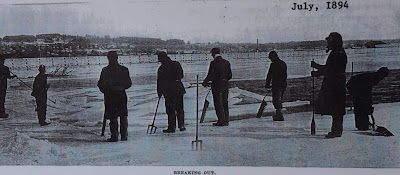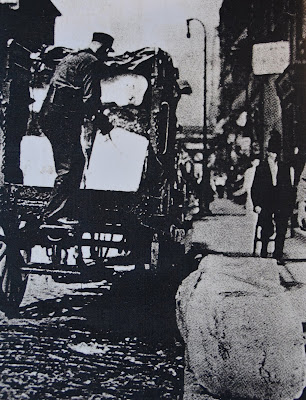 |
| Mr. Lynn Smoker's collection of ice harvesting tools. |
 |
| The frozen Susquehanna River can be seen in the distance. |
 |
| If there was heavy snow on the ice, it would be removed with an ice scraper to shave off the snow. |
 |
| These are saws from Mr. Smoker's collection. They would be used to saw through the ice along lines that were marked in a checkerboard style pattern. |
 |
| Eventually plows were used instead of the saws. This photo shows the plows cutting along the marked lines, through the ice. The horse drawn ice plow dates back to the 1890s. |
 |
| This shows a hand plow. |
 |
| This is known as breaking out and is done with hook chisels and breaking bars. The tools are used to break off large pre-cut ice pieces so they can be piked to the ice house. |
 |
| A selection of ice hooks from Mr. Smoker's collection. |
 |
| Another way to get the ice to the ice house is on wagons. |
 |
| The ramps were used to get the ice into the ice house. |
 |
| The lift was another way to get the ice into the ice house. |
 |
| Men would wear spikes on their boots while walking on the ice. |
 |
| The horses would wear horseshoes with spikes on them. |
 |
| The ice man making deliveries in neighborhoods. |
 |
| Another ice wagon making deliveries. |
 |
| Ice Axes and hatchets were used primarily in the ice houses as well as on the ice wagon to split blocks of ice before weighing them. |
 |
| This reminded me of an illustration from Saturday Evening Post. |
 |
| The iceman or the customer could use tools to shave or chip the ice. |
 |
| Mr. Smoker's collection of ice shavers and chippers. |
 |
| Ads showing cold-storage cupboards and refrigerators. |
 |
| Another ad showing upscale ice boxes. Looks like you could even sit on them. |
 |
| This photo and the next are ice boxes that belong to Mr. Smoker. |





No comments:
Post a Comment